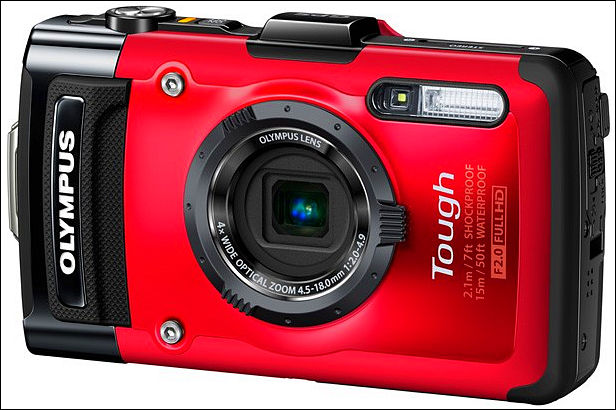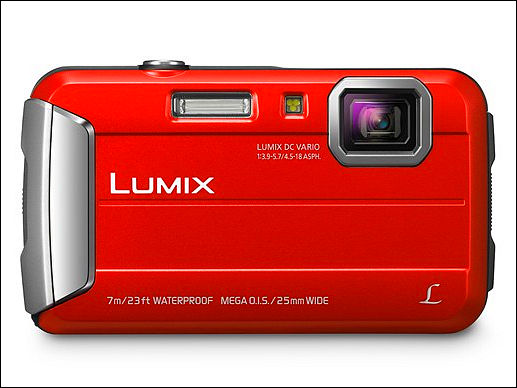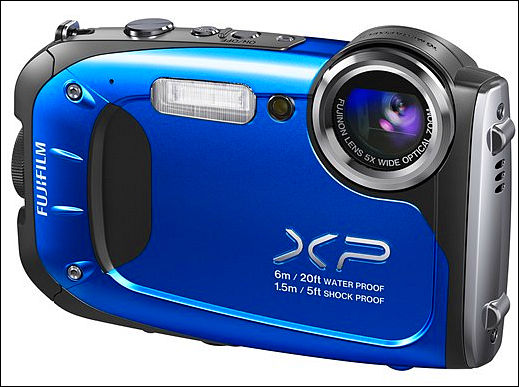
-
Olympus

TG-2 iHS - 12-megapixel CMOS sensor, 25-100mm equivalent f/2.0 lens and 1080p video
Links:
Panasonic

LUMIX TS5
- Waterproof to a depth of 39 feet, shockproof from a height of 6.5 feet, freeze proof down to a temperature of 14 degrees Fahrenheit and pressure resistant to 220 lbs
- 1920x1080, 50p Full HD
- Stereo microphone
- Wi-Fi connection with NFC
- Underwater mode
- 9.3x Intelligent Zoom and a 24mm Ultra Wide Angle LEICA DC lens
- 16.1-megapixel high sensitivity MOS Sensor
- GPS
Links:
FujiFilm

FinePix XP60
- 1/2.3-inch 16MP CMOS
- CMOS Shift Image Stabilization
- Waterproof to 20ft/6m
- Shockproof to 5ft/1.5m
- Dustproof
- Freezeproof to 14°F/-10ºC
- 1920 x 1080p60 video
Links:
-
FinePix XP200

- 1/2.3" 16MP CMOS sensor
- CMOS Shift Image Stabilization
- 5x optical FUJINON zoom lens, 28-140mm
- 3.0” LCD
- Wi-Fi
- 10fps continuous shooting
- 1080i60 movie
See
- http://www.dpreview.com/news/2013/03/22/Fujifilm-unveils-Finepix-XP200-rugged-compact-with-Wi-Fi
- http://www.engadget.com/2013/03/22/fujifilm-finepix-xp200-s8400w/
- http://www.photographyblog.com/news/fujifilm_finepix_xp200/?utm_source=feedburner&utm_medium=feed&utm_campaign=Feed%3A+photographyblog+PhotographyBLOG
-
Panasonic has OIS, the others are sensor shift. For an action camera, I 'personally' would choose OIS as a priority feature over everything else.
-
For an action camera, I 'personally' would choose OIS as a priority feature over everything else.
May I ask why?
-
Over the years of using little compacts, I've always favoured the way that optical stabilisation looks and feels over sensor shifting, for stills and more importantly video. It's one of the reasons I favour Panasonic, as I quite often like their OIS.
There's something about sensor shift that makes me notice it is there, more than optical. It's only subtle, but I find it less natural. I also find it's not as good at getting rid of the rough stuff. I don't mean massive undulation, just heavy vibrations.
Again, it's personal, but it's one of the first features I look for on a compact and walk about SLR lenses, especially the longer ones.
-
For me, it is the Olympus TG2. The other cameras start at f3.9 while the TG2 is f2.0. Also I have the original oldie SW770 and it has gone down way beyond its rated 10 meters many times and still tickling fine after all these years, and I never had to replace any seals.
-
Olympus TG2 review - http://www.neocamera.com/camera/olympus/tg2/review
-
Another Olympus Tough TG-2 Review - http://www.photographyblog.com/reviews/olympus_tough_tg_2_review/
-
For me it is the FT5 (TS5) - it does 108060p video, unlike all the others. Here are two examples:
You an download the original 108060p video.
-
Specs and photo for TS5 above are incorrect. I own the TS5 and it is a solid performer. Can shoot video or stills up to ISO 6400 (albeit with a lot of grain) and can even take stills with 30 second long exposure. Bitrate for 60p is 28MB/s and OIS is very impressive.
-
Panasonic TS5 (FT5) Time-Lapse
Select 1080p
The camera makes a 1920x1080 30 fps MP4 video from the set of stills using the built-in intervalometer. This video was made from 800 16 megapixel stills at 10-second intervals. The camera took less than 3 minutes to make the video. You can set the stills to be 16:9 so the video is widescreen but I did not.
-
Panasonic TS5 (FT5) wins 2013 TIPA award as Best Rugged Compact Camera
-
Olympus TG-830 iHS Review
This camera provides surprisingly good performance levels, both versus other tough cameras and versus others point-n-shoot models in its price range. The TG-830 works quickly with very little shutter lag and minimal shot to shot delays. Image quality is also pretty good with this camera, especially considering it has a very small image sensor, although you may notice some odd skin colors when shooting under fluorescent lighting and some softness at the edges of the scene. For a camera in its price range, Olympus included some very helpful advanced features with the TG-830 iHS, including a built-in GPS unit, an e-compass, double-locking switches on the memory card and USB compartments, a built-in LED light for additional illumination in underwater scenes, and an above average LCD screen. There are other tough cameras on the market that can work in deeper water than the TG-830's 33-foot depth limitation. And there are other non-waterproof cameras in this price range that perform better than the TG-830. However, you aren't going to find many other cameras that can combine the tough features and performance included in this model at this price. If you can live with a couple of significant drawbacks -- a small 5x optical zoom lens and poorly labeled control buttons that are too small to be used comfortably -- the Olympus TG-830 iHS is going to provide a very good value to those seeking a beginner-level tough camera.
http://www.steves-digicams.com/camera-reviews/olympus/tg-830/olympus-tg-830-ihs-review.html
-
Roundup TG2 best overall TS5 best video
http://www.digitalcamerainfo.com/features/2013-waterproof-camera-roundup
-
Fujifilm FinePix XP200 Review
The Fujifilm FinePix XP200 is very tough, with a rating of 2 metres shock proof, as well as waterproof down to 15 metres, making it one of the tougher waterproof cameras available. The Fujifilm FinePix XP200 is good value for money, with lots of features including 60fps full HD video with optical image stabilisation, although we would have preferred to see better image quality from the camera. However, if you mostly share to the web, then the built in Wi-Fi will appeal, as well as the different colours the camera is available in.
http://www.ephotozine.com/article/fujifilm-finepix-xp200-review-22028
-
The Olympus Tough TG-2 is a rugged compact camera with full Hd video recording, a bright f/2.0 lens, and an extremely impressive macro mode. The camera gives some level of manual controls with a new aperture priority mode. Images are good, with excellent colour reproduction, although detail is not as good as it could be. We also struggled to take a decent panorama shot. We were also disappointed by the lens noise picked up during video recording. The camera responds quickly, and has 5fps continuous shooting at full resolution. Rather uniquely the camera can also use a fish-eye or 1.7x telephoto convertor lens giving additional shooting options. If you are looking for a tough waterproof camera, and would like to have the option to expand your kit with adapters, or love taking close up macro photos, then the Olympus Tough TG-2 is recommended.
-
The TG-2's other big claim to fame is its lens, which has a maximum aperture range of F2.0-4.9. At wide-angle, that's at least a full stop faster than most of the competition. Since more light is coming in, you can use faster shutter speeds, and won't need to crank up the sensitivity as quickly. However, the lens' maximum aperture at the telephoto end is less impressive, and more in-line with the competition. The TG-2 is also unique in that it supports telephoto and fish-eye conversion lenses - and yes, they're waterproof too.
The TG-2 has the usual features that you'll find on most point-and-shoot cameras. They include an 'Intelligent' auto mode, special effects ('Magic Filters'), and a large selection of scene modes (cat mode, anyone?). There are three ways to create panoramic images (two of them are stitched together right on the camera), and the results are satisfying. Olympus has taken things a step further on the TG-2, providing an aperture priority mode to go along with all those auto modes. While the Av mode isn't perfect, as it only gives you three choices at any given focal length, it's more than you'll find on other compact cameras and can prevent overexposure in exceptionally bright conditions (as well as allowing you to use long shutter speeds for light-trails, waterfalls etc).
-
The TG-2's tough settings include its ability to descend to depths of up to 50ft. without having any additional housing, withstand falls from up to 7ft, handle pressure up to 220lbs, temperatures down to 14° F and is completely dustproof once it has been closed up and locked. One of the keys to these abilities are the rubber gaskets on both doors that open. Once they are closed, the gaskets keep everything air tight to protect the camera. To make sure the doors are closed before use, they both feature a latch and lock system so there are no worries of them accidentally opening. The GPS is an excellent feature for anyone that likes to travel, recording where you captured images as well as pointing out nearby landmarks with the digital compass
Capturing movies with the TG-2 is fast and easy, since the camera is always ready to start recording at the push of a button. It captures smooth, sharp video in most lighting situations. Playback is smooth and enjoyable on the camera, computer or HDTV via the HDMI port on the camera. When watching on the camera your audio will come from a small built-in speaker that is no problem to hear in quiet surroundings. As with most digicams, the small microphone for recording audio is very sensitive and will not record what you shooting. Try to limit background noise using the wind and recording controls in the menu and positioning yourself away from background noises.
http://www.steves-digicams.com/camera-reviews/olympus/tg-2/olympus-tg-2-review.html
-

Taking your camera on vacation should be a fun experience, not a hassle. It's so much easier to enjoy your time at the beach if you do not have to worry about sand in your camera or having it waterlogged by waves or rain. The Olympus TG-2 gets my seal of approval for being the best rugged camera I have seen so far.
http://www.digitalcamerareview.com/default.asp?newsID=5349&news=olympus+tg-2+best+rugged+camera
-
Coolpix can go further underwater than any rugged camera on the market: 18 meters (59 feet). It can also be dropped from 2 meters, if you're on the clumsy side.
The Coolpix AW110 takes good quality photos, given the audience and shooting situations at which it is aimed. Exposure is generally accurate, though like most compacts, the AW110 will clip highlights. Colors are vibrant and pleasing to the eye.
-
The Lumix DMC-TS5/FT5 is the flagship model in Panasonic's rugged camera lineup. Panasonic has stuffed virtually every conceivable feature into the TS5, including a GPS, Wi-Fi, and NFC capability. While those are nice add-ons, performance and photo quality remain the most important 'features' a camera can have. In that regard, the DMC-TS5 rarely disappoints.
You generally won't do a lot of waiting when using the DMC-TS5. The camera starts up in under a second, and focuses very quickly in good light
TS5 exposes well and has less highlight clipping than your average compact.
-
Photos are appealing when downsized or printed, but don't look as nice when viewed at 100%. The WG-3 produces images with vivid colors and accurate exposure and like most of its peers will clip highlights at times (though the highlight correction feature can reduce that). When it comes to sharpness, the WG-3 handles edges and high contrast areas well, but it smudges the details with the best of them in low contrast areas (such as grass, shrubs, and hair). Both fringing and chromatic aberrations were strong at times, though you'll only notice that if you're pixel-peeping.
The Pentax WG-3 GPS offers a rugged design and a good set of core features - with a couple of extras compared to the non-GPS model.
-
Pentax Optio WG-3 Review
The WG-3 is the 15th generation of Pentax's ruggedized camera range, and it certainly shows. This is a solid product in more ways than one, both in terms of its build quality, ability to withstand most things that you could subject it to, and all-round handling and feature-set. The loud styling might not be to everyone's tastes, but the Pentax WG-3 certainly fits the bill as a nigh-on indestructible camera fit for both family life and more extreme pastimes.
http://www.photographyblog.com/reviews/pentax_optio_wg3_review/
Howdy, Stranger!
It looks like you're new here. If you want to get involved, click one of these buttons!
Categories
- Topics List23,993
- Blog5,725
- General and News1,354
- Hacks and Patches1,153
- ↳ Top Settings33
- ↳ Beginners256
- ↳ Archives402
- ↳ Hacks News and Development56
- Cameras2,368
- ↳ Panasonic995
- ↳ Canon118
- ↳ Sony156
- ↳ Nikon96
- ↳ Pentax and Samsung70
- ↳ Olympus and Fujifilm102
- ↳ Compacts and Camcorders300
- ↳ Smartphones for video97
- ↳ Pro Video Cameras191
- ↳ BlackMagic and other raw cameras116
- Skill1,960
- ↳ Business and distribution66
- ↳ Preparation, scripts and legal38
- ↳ Art149
- ↳ Import, Convert, Exporting291
- ↳ Editors191
- ↳ Effects and stunts115
- ↳ Color grading197
- ↳ Sound and Music280
- ↳ Lighting96
- ↳ Software and storage tips266
- Gear5,420
- ↳ Filters, Adapters, Matte boxes344
- ↳ Lenses1,582
- ↳ Follow focus and gears93
- ↳ Sound499
- ↳ Lighting gear314
- ↳ Camera movement230
- ↳ Gimbals and copters302
- ↳ Rigs and related stuff273
- ↳ Power solutions83
- ↳ Monitors and viewfinders340
- ↳ Tripods and fluid heads139
- ↳ Storage286
- ↳ Computers and studio gear560
- ↳ VR and 3D248
- Showcase1,859
- Marketplace2,834
- Offtopic1,320





